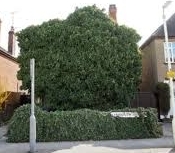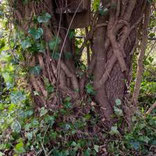A customer has asked to put up a description of their new book. Not to purchase, simply for your thoughts.
Dark story of Gaslighting, abuse, retribution,
and Hope. Based on real conversations with Willow a Hidden Person, and
Richard who removes the so called ‘Pillars-of-society' blocking Willow's pathway to the therapy she will need to escape and recover. He’s aware of the consequences. However, had turned a blind
eye and covered his ears to evil too often. It’s a risk he is going to take. Has no close family or friends for whose safety he’s concerned. His military service and work for the ‘Organisation’
add credibility to his account of the retribution he hands out.
Bella and Richard’s love story sprinkles some sunshine onto this dark tale. Bella is unaware, even when her husband disappears, of the retribution Richard is carrying out to stop Willows abusers.
However, is aware he works for ‘The Organisation,’ but not who they are, or what he is paid to do!
How to Kill ivy on brickwork, fencing and gardens
Badgers Rats Bramble Dandelions Knotweed Weeds in Gravel Bindweed Horsetail Slugs Foxes Leather jackets
Ivy may look attractive, but ...
Ivy quickly becomes one of the biggest garden pests of all. Choking out native plants, ruining trees, damaging windows and even our roofs and guttering, any small gap it can get its tendrils into will eventually be damaged.
Dense ivy ground cover forms a shelter for rats is slug heaven and the dust it collects can cause breathing problems for those with allergies. This article explains how to kill and get rid of ivy.


This Gallop product is the quick and easy way I use to remove Ivy from brickwork, garden fences, trees or your garden borders. Click on the amazon picture For
information or follow the DIY tips on this page.
Can Ivy growing on walls, stonework or trees be a problem?
Yes! in these circumstances it is;
- Ivy ground cover smothers native plants, preventing sunlight from reaching leaves.
- Ivy growing on trees can cover branches, preventing new buds eventually killing them. The leaves prevent any light from reaching the tree bark preventing activation of any dormant buds.
- The pure weight and mass of mature ivy can make trees blow-over in high winds.
The problem with Ivy growing on walls, stonework or trees explained here.
- Ivy creeps into neighbouring gardens, your home, your roof and blocks guttering.
- Ivy can transmit bacterial leaf scorch, which threatens native elms, oaks and maples.
- Ivy does not stabilise sloped gardens because its roots are shallow, it actually makes the problem worse because it smothers other deep-rooted plants that would stabilise the slope.
- If your neighbour neglects the garden. It is almost impossible to stop ivy creeping over, under and through neighbouring fences and walls.
- You could try asking your neighbours to control it, but it is probably easier to check now and again and destroy it yourself.
What's good about Ivy
- All those old English houses that have been standing for centuries are mostly held together by ivy. Ivy does not cause mortar to crumble or harm fired clay bricks.
- The additional insulating layer of ivy keeps heat in, reducing the heating bill quite significant for those ivy clad old houses
- Ivy provides a natural habitat and food for birds and wildlife in your garden.
- It is a cheap and attractive way of covering up an unsightly wall.
How to kill and clear Ivy from trees, brickwork, stone walls, fencing and the ground.
Clear all ivy vines out about two feet from the base trees. If any of the vines are too thick or difficult to dig or pull out of the ground, (on stony ground it's almost impossible to dig or pull out ivy roots), treat the cut vine immediately after cutting with a glyphosate based weed-killer, being careful not to spray any plants you want to keep.
Now the back breaking work, pull or dig up the remaining untreated ivy from the ground. If you have a large area it makes sense to dig up the plants you want to keep. Then, cut or break off the ivy vines, leaving about a foot of vine with leaves above ground and treat the whole area with glyphosate.
Disposing of cut Ivy.
To dispose of the cut ivy the best way is to burn it or it can be left on a ground-sheet in a heap to die off.
Check your contractor is not going to shift your problem to someone else by dumping it in a field somewhere. Small amounts can be tied in a bin bag to rot and then added to your compost heap. Never add living green ivy to your compost heap.
Eradicating Ivy from your garden.
Generally it is very difficult to kill an entire ivy plant with the first application of herbicide or by digging/pulling ivy roots out. You will almost certainly have to selective spray or dig now and again over the coming months to eradicate the Ivy pest completely.
Even when you think you have won the battle, a bird will dump an Ivy seed smack bang right in the middle of your garden. A new shoot will appear over your neighbours wall or under the boundary fence. Keep on top of it.
I don't like using chemicals, but in the case of Ivy I feel its justified, spraying the growing leaves with weed killers containing Glyphosate (it attacks the leaves and the roots) will kill of the plant. You may need to repeat this. (read the label)
Clearing and removing Ivy from brickwork, brick walls and stone walls.
Ivy growing over your home can look good, but if it creeps into chimneys, widow frames, guttering, roof tiles and under fascias it can be a problem and very difficult and costly to remove especially from a building with two or more stories.
Again, there is not a quick n' easy way to remove Ivy from brickwork or gardens, but these DIY tips may help.
Pull or lever the ivy away from the wall, starting from the highest growth and working down. If there are several vines growing up the wall, work from one side until you have removed all the ivy from the brickwork.
The tendrils (ivy feet), the hairy bits that get into the crevices and help the ivy to hold onto the brickwork will be hard to remove. You can pry these off with a putty knife. Normally these feet will dry up and disappear. If they continue to grow you will need to chemically treat them. I wish there was a "greener way" but I haven't found one yet.
You will need to be careful when pulling the ivy away and scraping the tendrils from the brickwork as brick and mortar can be chipped off or break away. It may be safer to cut the ivy away with shears. If the ivy has been growing on the brickwork for years, the evidence that it has been there will take a few years to completely disappear.
If the ivy root is not growing from the foundations, through concrete or your patio, dig the root out. If you can't get to the ivy root, chop the ivy down as close to the root as possible. Don't add Ivy to your garden compost heap until its completely rotted, tips on rotting ivy and bindweed down can be found on my gardening tips page.
Spray any remaining roots with a Glyphosate based weed killer. This will need to be carried out every now and then, until the ivy gives up and dies.
If the Ivy roots are growing in a neighbours garden, there's not a lot you can do but keep trimming it back, unless they agree to you removing or treating the roots.
If you are planning to remove ivy yourself from high up hire a cherry picker. If you cant get a cherry picker in make sure you have got someone, who likes you, holding onto the ladder.
The best and quickest way and the cheapest weed-killer for clearing Ivy.
Super concentrated (360g/l) and the best value glyphosate weed killer that kills the whole plant and the roots.
A lot cheaper than branded premixes. Twelve ml per litre is all that's required for something like a sprayer. Sixty ml in five litres of water will kill 100 sq metres. Weeds should start to die back in 1-2 weeks.
Don't be frightened off by the price, this two Litre bottle (360) Dilutes to treats up to 3332 sq/m
Strongest Weed killer available online in the U.K. For uncertified Use. Contains 360 g/l glyphosate,
One Litre Treats Over 0.4 of an Acre Offering the Best Value Available.
Gallup Home&Garden is a domestic weed killer that contains 360 g/l glyphosate for effective control of annual and deep-rooted perennial garden weeds, including grass, docks, nettles, Willow herb, dandelion and bindweed. Kills most weeds in one application with no need to re-apply. A single two litre bottle treats up to 3332 sq/m



